An Electricity Consumption Disaggregation Method for HVAC Terminal Units in Sub-Metered Buildings Based on CART Algorithm
Abstract
:1. Introduction
1.1. The Status Quo of Sub-Metering Systems
1.2. Non-Intrusive Load Monitoring (NILM) Method
- (1)
- This study adopts a CART algorithm to disaggregate the real-time electricity consumption of HVAC terminal units. It makes up for the deficiency that the Fourier series model is not suitable for categorical data.
- (2)
- A general disaggregation framework is proposed. It can be easily extended to different cases without constructing physical building energy models.
2. Methodology
2.1. Principle of CART Algorithm
2.2. Establishment of an Extended CART Algorithm for HVAC Sub-Metering Systems
2.2.1. Data Pre-Processing
2.2.2. Input Variable Selection
2.2.3. Training Period Selection
2.2.4. Electricity Consumption Prediction of Lighting-Plug System
2.2.5. Electricity Consumption Calculation of HVAC Terminal Units
3. Case Study
3.1. Data Pre-Processing
3.2. Input Variable Selection
3.3. Training Period Selection
3.4. Electricity Consumption Disaggregation Results of Lighting-Plug System
3.5. Electricity Consumption Calculation of HVAC Terminal Units
4. Discussion
5. Conclusions
Author Contributions
Funding
Data Availability Statement
Conflicts of Interest
Abbreviations
| HVAC | Heating, Ventilation and Air Conditioning |
| VAV | Variable Air Volume System |
| CART | Classification and Regression Tree |
| NILM | Non-intrusive Load Monitoring |
| EDA | End-use Disaggregation Algorithm |
| ANN | Artificial Neural Network |
| Gini | Gini Impurity |
| CV | Coefficient of Variability |
| WMAPE | Weighted Mean Absolute Percentage Error |
| WHC | Working Hours in Cooling Season |
| WHH | Working Hours in Heating Season |
| NW | Non-working Hours |
| EL_cal | Calculated lighting-plug electricity consumption in the air conditioning season (kWh) |
| Emix | Mixed electricity consumption of the lighting plug and HVAC terminal units (kWh) |
| Eter | Electricity consumption of terminal units in the air conditioning system (kWh) |
| E | Electricity consumption (kWh) |
| Pi | Instantaneous power (kW) |
| τ | Count cycle of instantaneous power (min). |
| D | Days in one year |
| M | Months from January to December |
| T | Date types |
| H | Equipment use time |
| EMi | Metered electricity consumption of the ith data point (kWh) |
| Epi | Predicted electricity consumption of the ith data point (kWh) |
| N | Total point number of the dataset |
| Multiple-computing-mean time (s) |
References
- IEA. Buildings: IEA, Paris. License: CC BY 4.0. 2022. Available online: https://www.iea.org/reports/buildings (accessed on 10 December 2022.).
- Building Energy Conservation Research Center of Tsinghua University. Annual Report on China Building Energy Efficiency 2022; Building Energy Conservation Research Center of Tsinghua University: Beijing, China, 2022. [Google Scholar]
- Hart, G.W. Nonintrusive appliance load monitoring. Proc. IEEE 1992, 80, 1870–1891. [Google Scholar]
- Howard, E. California. Guide to the Implementation of Tenant Submetering and Billing for Commercial Buildings in Northern California; SILO Inc.: Brooklyn, NY, USA, 2008. [Google Scholar]
- Ministry of Finance of the People's Republic of China. Interim Measures for the Administration of Special Funds for Energy Saving of State-owned Buildings and Large-scale Public Buildings; Document No. 5582007; Ministry of Finance of the People's Republic of China: Beijing, China, 2007.
- Junruo, W. Case analysis on energy consumption of large-scale public buildings in shanghai area based on partial subentry measurement system. New Build. Mater. 2010, 37, 48–50. [Google Scholar]
- Zhang, H.W.Q.; Li, Y.; Wang, X. Research and development on electricity sub-metering system for large public buildings (Part Ⅰ): System structure. Heat. Vent. Air Cond. 2010, 40, 10–13+50. [Google Scholar]
- Wang, X.W.Q.; Shen, Q.; Zhang, H. Research and development on electricity sub-metering system for large public buildings (Part Ⅱ): Uniform model and methodology of energy consumption classification. Heat. Vent. Air Cond. 2010, 40, 14–17. [Google Scholar]
- Tongji University BEAD. Building Energy Consumption Sub-metering Data Status and Application Seminar; Tongji University BEAD: Shanghai, China, 2016. [Google Scholar]
- Ministry of Housing and urban-rural development of the People’s Republic of China. Technical Guideline for Sub-Metering Data Collection of Energy Consumption Monitoring System in State-Owned Buildings and Large-Scale Public Buildings; Document No. 114; Ministry of Housing and urban-rural development of the People’s Republic of China: Beijing, China, 2008.
- Qu, Y.; Zhang, Z.; Wang, H.; Yang, F. Energy Consumption Analysis of Public Buildings Located in the Severe Cold Region. Procedia Eng. 2017, 205, 2111–2117. [Google Scholar]
- Guo, C.; Bian, C.; Liu, Q.; You, Y.; Li, S.; Wang, L. A new method of evaluating energy efficiency of public buildings in China. J. Build. Eng. 2022, 46, 103776. [Google Scholar]
- Sizirici, B.; Fseha, Y.; Cho, C.-S.; Yildiz, I.; Byon, Y.-J. A Review of Carbon Footprint Reduction in Construction Industry, from Design to Operation. Materials 2021, 14, 6094. [Google Scholar] [CrossRef]
- Granderson, J.; Lin, G.; Singla, R.; Fernandes, S.; Touzani, S. Field evaluation of performance of HVAC optimization system in commercial buildings. Energy Build. 2018, 173, 577–586. [Google Scholar] [CrossRef]
- Marceau, M.; Zmeureanu, R. Nonintrusive load disaggregation computer program to estimate the energy consumption of major end uses in residential buildings. Energy Convers. Manag. 2000, 41, 1389–1403. [Google Scholar] [CrossRef] [Green Version]
- Laughman, C.; Lee, K.; Cox, R.; Shaw, S.; Leeb, S.; Norford, L.; Armstrong, P. Power signature analysis. IEEE Power Energy Mag. 2003, 1, 56–63. [Google Scholar]
- Giri, S.; Bergés, M. An energy estimation framework for event-based methods in Non-Intrusive Load Monitoring. Energy Convers. Manag. 2015, 90, 488–498. [Google Scholar] [CrossRef]
- Murata, H.; Onoda, T. Estimation of power consumption for household electric appliances. In Proceedings of the Conference Estimation of Power Consumption for Household Electric Appliances, Singapore, 18–22 November 2002; Volume 5, pp. 2299–2303. [Google Scholar]
- Liu, Q.; Nakoty, F.M.; Wu, X.; Anaadumba, R.; Liu, X.; Zhang, Y.; Qi, L. A secure edge monitoring approach to unsupervised energy disaggregation using mean shift algorithm in residential buildings. Comput. Commun. 2020, 162, 187–195. [Google Scholar] [CrossRef]
- Dash, S.; Sahoo, N. Electric energy disaggregation via non-intrusive load monitoring: A state-of-the-art systematic review. Electr. Power Syst. Res. 2022, 213, 108673. [Google Scholar] [CrossRef]
- Norford, L.K.; Mabey, N. Non-Intrusive Electric Load Monitoring in Commercial Buildings. Symposium on Improving Building Systems in Hot and Humid Climates; Texas A&M University: College Station, TX, USA, 1992. [Google Scholar]
- Norford, L.K.; Leeb, S.B. Non-intrusive electrical load monitoring in commercial buildings based on steady-state and transient load-detection algorithms. Energy Build. 1996, 24, 51–64. [Google Scholar] [CrossRef]
- Rafsanjani, H.N.; Ahn, C. Linking Building Energy-Load Variations with Occupants’ Energy-Use Behaviors in Commercial Buildings: Non-Intrusive Occupant Load Monitoring (NIOLM). Procedia Eng. 2016, 145, 532–539. [Google Scholar] [CrossRef] [Green Version]
- Rafsanjani, H.N.; Ahn, C.R.; Chen, J. Linking building energy consumption with occupants’ energy-consuming behaviors in commercial buildings: Non-intrusive occupant load monitoring (NIOLM). Energy Build. 2018, 172, 317–327. [Google Scholar] [CrossRef]
- Kaselimi, M.; Doulamis, N.; Doulamis, A.; Voulodimos, A.; Protopapadakis, E. Bayesian-optimized Bidirectional LSTM Regression Model for Non-intrusive Load Monitoring. In Proceedings of the ICASSP 2019–2019 IEEE International Conference on Acoustics, Speech and Signal Processing (ICASSP), Brighton, UK, 12–17 May 2019; pp. 2747–2751. [Google Scholar]
- Schirmer, P.A.; Mporas, I.; Paraskevas, M. Evaluation of Regression Algorithms and Features on the Energy Disaggregation Task. In Proceedings of the 2019 10th International Conference on Information, Intelligence, Systems and Applications (IISA), Patras, Greece, 15–17 July 2019; pp. 1–4. [Google Scholar]
- Kaselimi, M.; Protopapadakis, E.; Voulodimos, A.; Doulamis, N.; Doulamis, A. Multi-Channel Recurrent Convolutional Neural Networks for Energy Disaggregation. IEEE Access 2019, 7, 81047–81056. [Google Scholar] [CrossRef]
- Yang, D.; Gao, X.; Kong, L.; Pang, Y.; Zhou, B. An Event-Driven Convolutional Neural Architecture for Non-Intrusive Load Monitoring of Residential Appliance. IEEE Trans. Consum. Electron. 2020, 66, 173–182. [Google Scholar] [CrossRef]
- Faustine, A.; Pereira, L.; Bousbiat, H.; Kulkarni, S. UNet-NILM: A Deep Neural Network for Multi-Tasks Appliances State Detection and Power Estimation in NILM. In Proceedings of the 5th International Workshop on Non-Intrusive Load Monitoring NILM’20 Association for Computing Machinery, New York, NY, USA, 18 November 2020; pp. 84–88. [Google Scholar]
- Xia, M.; Liu, W.; Wang, K.; Song, W.; Chen, C.; Li, Y. Non-intrusive load disaggregation based on composite deep long short-term memory network. Expert Syst. Appl. 2020, 160, 113669. [Google Scholar] [CrossRef]
- Guo, Y.; Xiong, X.; Fu, Q.; Xu, L.; Jing, S. Research on non-intrusive load disaggregation method based on multi-model combination. Electr. Power Syst. Res. 2021, 200, 107472. [Google Scholar] [CrossRef]
- Monteiro, R.; de Santana, J.; Teixeira, R.; Bretas, A.; Aguiar, R.; Poma, C. Non-intrusive load monitoring using artificial intelligence classifiers: Performance analysis of machine learning techniques. Electr. Power Syst. Res. 2021, 198, 107347. [Google Scholar] [CrossRef]
- Samadi, M.; Fattahi, J. Energy use intensity disaggregation in institutional buildings—A data analytics approach. Energy Build. 2021, 235, 110730. [Google Scholar] [CrossRef]
- Xiao, Z.; Gang, W.; Yuan, J.; Zhang, Y.; Fan, C. Cooling load disaggregation using a NILM method based on random forest for smart buildings. Sustain. Cities Soc. 2021, 74, 103202. [Google Scholar] [CrossRef]
- Athanasiadis, C.; Doukas, D.; Papadopoulos, T.; Chrysopoulos, A. A Scalable Real-Time Non-Intrusive Load Monitoring System for the Estimation of Household Appliance Power Consumption. Energies 2021, 14, 767. [Google Scholar] [CrossRef]
- Shao, H.; Marwah, M.; Ramakrishnan, N. A Temporal Motif Mining Approach to Unsupervised Energy Disaggregation: Applications to Residential and Commercial Buildings. Proc. Conf. AAAI Artif Intell 2013, 27, 1327–1333. [Google Scholar] [CrossRef]
- Burak, G.H.; Shi, Z.; Wilton, I.; Bursill, J. Disaggregation of commercial building end-uses with automation system data. Energy Build. 2020, 223, 110222. [Google Scholar]
- Zaeri, N.; Ashouri, A.; Gunay, H.B.; Abuimara, T. Disaggregation of electricity and heating consumption in commercial buildings with building automation system data. Energy Build. 2021, 258, 111791. [Google Scholar] [CrossRef]
- Elafoudi, G.; Stankovic, L.; Stankovic, V. Power disaggregation of domestic smart meter readings using dynamic time warping. In Proceedings of the Conference Power Disaggregation of Domestic Smart Meter Readings Using Dynamic Time Warping, Athens, Greece, 21–23 May 2014; pp. 36–39. [Google Scholar]
- Kolter, J.Z.; Batra, S.; Ng, A.Y. Energy Disaggregation via Discriminative Sparse Coding. In Proceedings of the 23rd International Conference on Neural Information Processing Systems, Vancouver, Canada, 6–9 December 2010; Volume 1, pp. 1153–1161. [Google Scholar]
- Matsui, K.; Yamagata, Y.; Nishi, H. Disaggregation of Electric Appliance’s Consumption Using Collected Data by Smart Metering System. Energy Procedia 2015, 75, 2940–2945. [Google Scholar]
- Dhar, A.; Reddy, T.A.; Claridge, D.E. A Fourier Series Model to Predict Hourly Heating and Cooling Energy Use in Commercial Buildings with Outdoor Temperature as the Only Weather Variable. J. Sol. Energy Eng. 1999, 121, 47–53. [Google Scholar] [CrossRef]
- Dhar, A.; Reddy, T.A.; Claridge, D.E. Modeling Hourly Energy Use in Commercial Buildings with Fourier Series Functional Forms. J. Sol. Energy Eng. 1998, 120, 217–223. [Google Scholar] [CrossRef]
- Dhar, A.; Reddy, T.A.; Claridge, D.E. Generalization of the Fourier Series Approach to Model Hourly Energy Use in Commercial Buildings. J. Sol. Energy Eng. 1999, 121, 54–62. [Google Scholar] [CrossRef]
- Ji, Y.; Xu, P.; Ye, Y. HVAC terminal hourly end-use disaggregation in commercial buildings with Fourier series model. Energy Build. 2015, 97, 33–46. [Google Scholar] [CrossRef]
- Fan, C.; Wang, J.; Gang, W.; Li, S. Assessment of deep recurrent neural network-based strategies for short-term building energy predictions. Appl. Energy 2018, 236, 700–710. [Google Scholar] [CrossRef]
- Parzen, E.; Pandit, S.M.; Wu, S.-M. Time Series and System Analysis with Applications. J. Am. Stat. Assoc. 1985, 80, 251. [Google Scholar] [CrossRef]
- Braun, J.E. Performance and control characteristics of a large cooling system. ASHRAE Trans. 1987, 93, 1830–1852. [Google Scholar]
- Claridge, D.E.; Haberl, J.S.; Turner, D.; O'Neal, D.L.; Jaeger, S. Improving energy conservation retrofits with measured savings. ASHRAE J. 1991, 33, 10–14. [Google Scholar]
- Ji, Y.; Xu, P. A bottom-up and procedural calibration method for building energy simulation models based on hourly electricity submetering data. Energy 2015, 93, 2337–2350. [Google Scholar] [CrossRef]
- Lior, R.; Maimon, O. Data Mining with Decision Trees: Theory and Applications; World Scientific Publishing Co. Inc.: Singapore, 2007. [Google Scholar]
- James, G.; Witten, D.T.H. An Introduction to Statistical Learning; Springer: New York, NY, USA, 2013; Volume 103, pp. 78–129. [Google Scholar]
- Breiman, L.; Friedman, J.R.O.; Stone, C. Classification and Regression Trees; Wadsworth International Group: Belmont, CA, USA, 1984; Volume 40, pp. 17–23. [Google Scholar]
- Breiman, L.; Friedman, J.H.R.O. Classification and Regression Trees. Wadsworth & Brooks. J. Am. Stat. Association. 1984, 18, 358. [Google Scholar]
- Wang, H.; Xu, P.; Lu, X.; Yuan, D. Methodology of comprehensive building energy performance diagnosis for large commercial buildings at multiple levels. Appl. Energy 2016, 169, 14–27. [Google Scholar] [CrossRef]
- Fu, Y.; Li, Z.; Feng, F.; Xu, P. Data-quality detection and recovery for building energy management and control systems: Case study on submetering. Sci. Technol. Built Environ. 2016, 22, 798–809. [Google Scholar] [CrossRef]
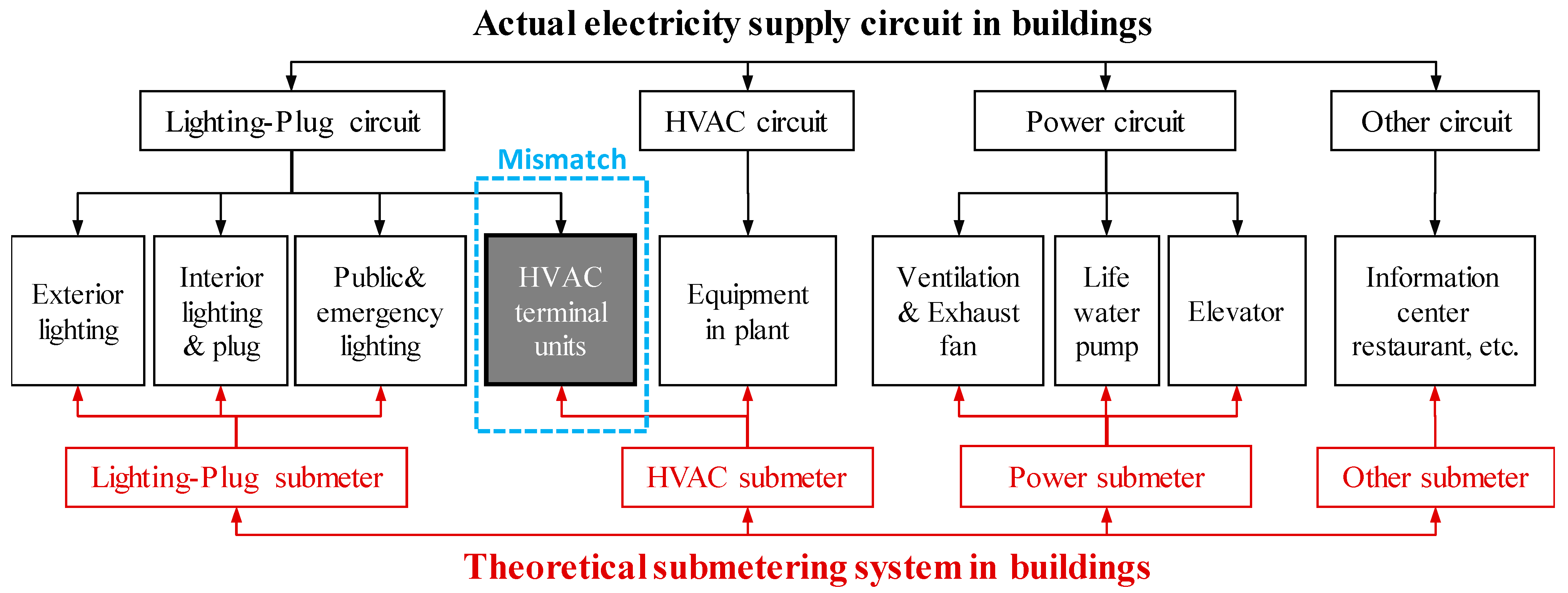
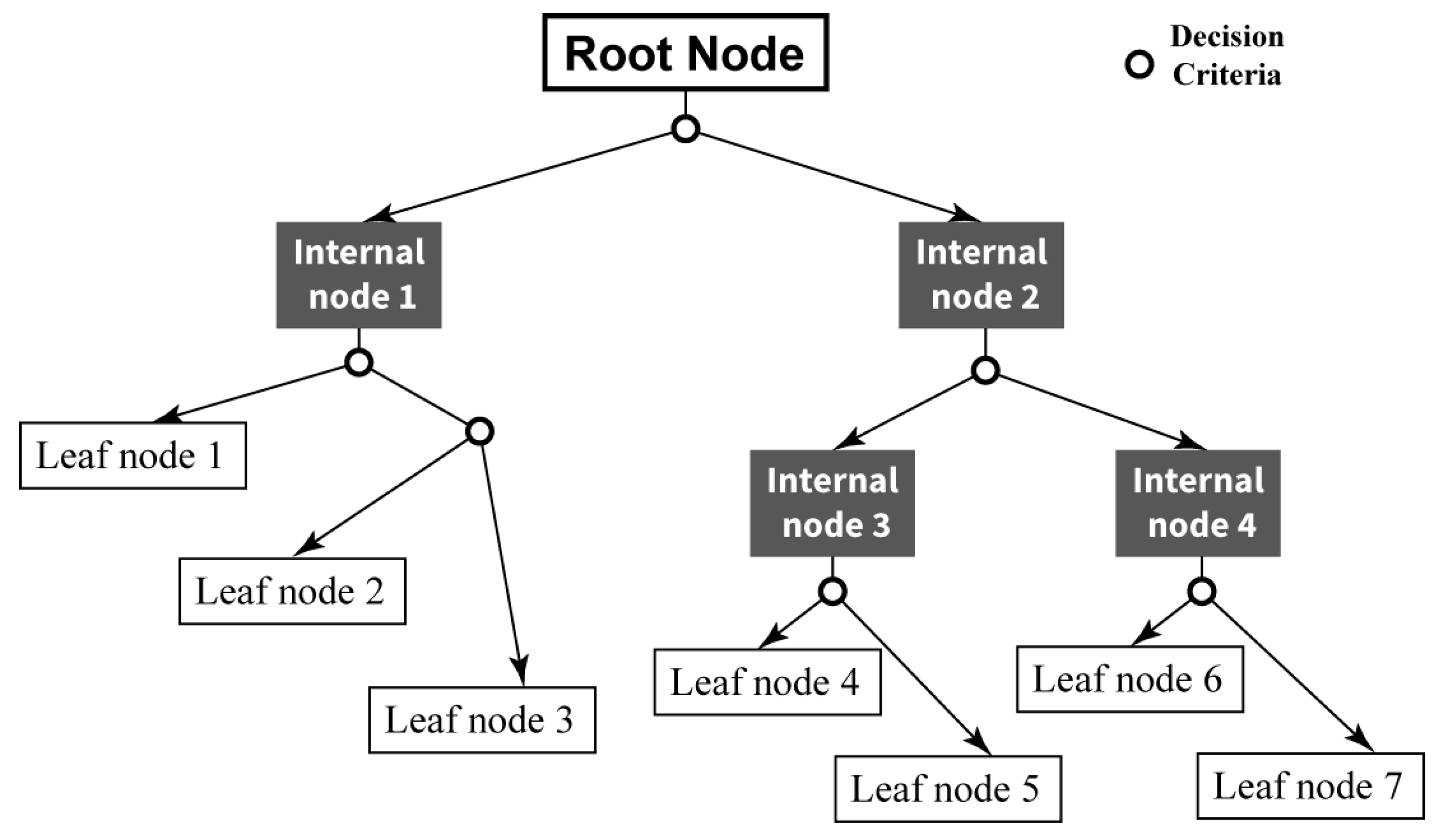

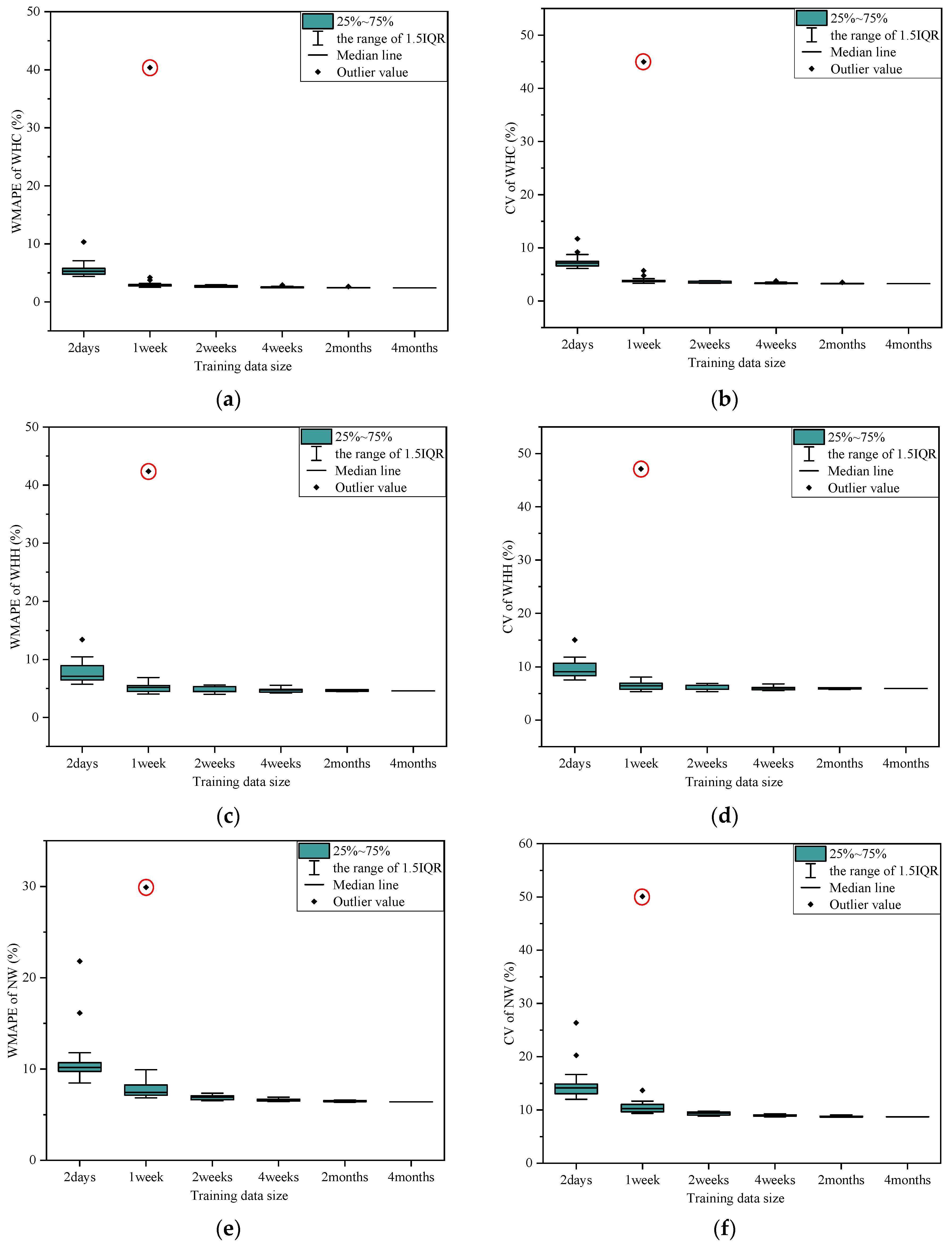


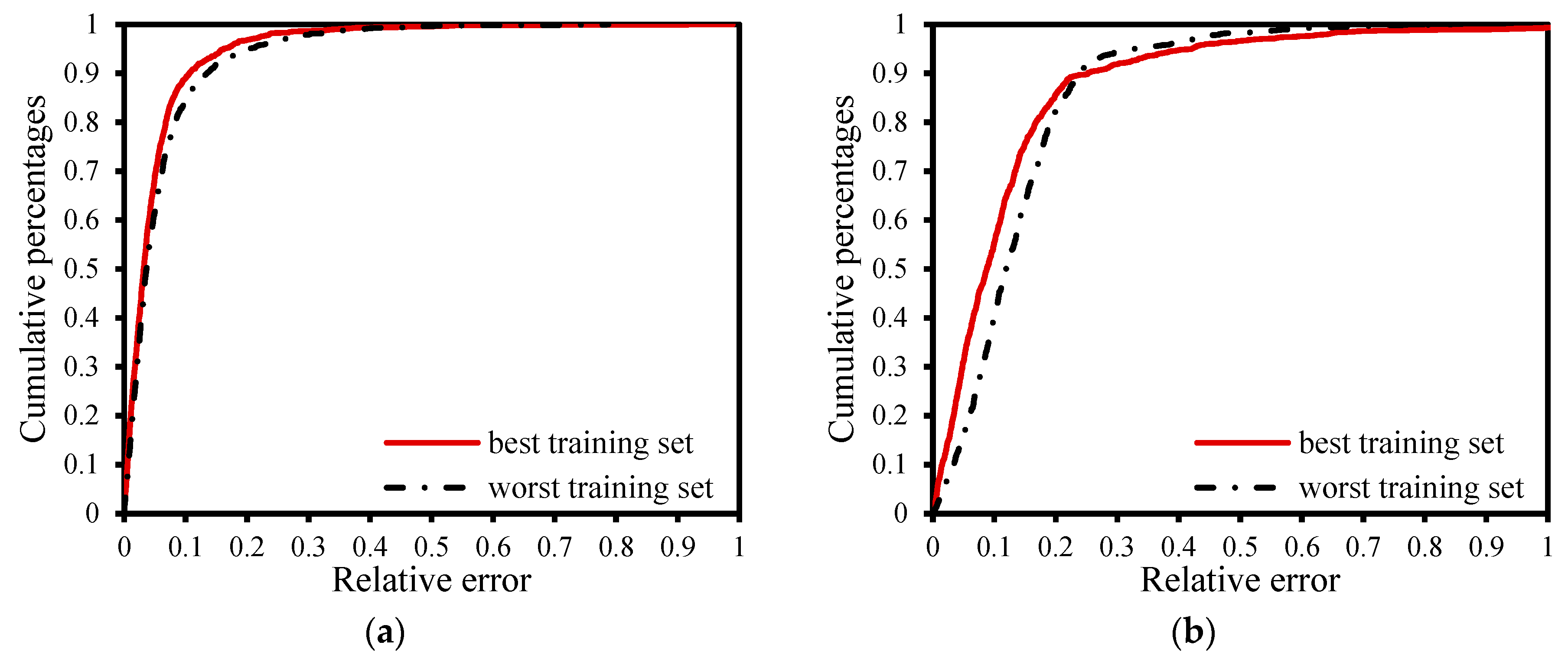
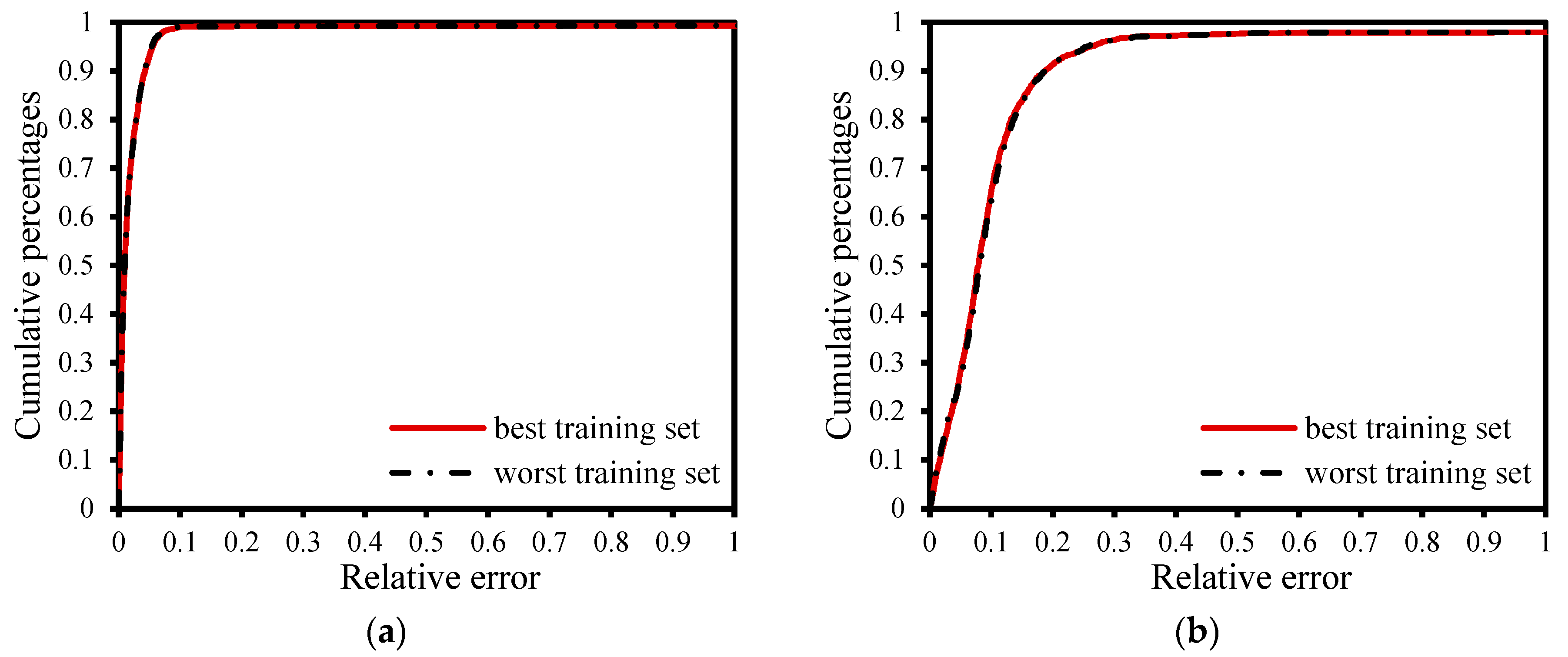
| No. | Author | Method | Building Type | Inputs | Output | Reference |
|---|---|---|---|---|---|---|
| 1 | Rafsanjani et al. | Machine learning | Commercial building | Occupant, minimum numbers of data points, entry events, and departure events | Occupants’ power changes | [23,24] |
| 2 | Kaselimi et al. | Machine learning | Residential building | Aggregate energy signals over a time window | The consumption of electric appliances | [25] |
| 3 | Schirmer et al. | Machine learning | Residential building | Statistical features, line currents, line voltages, and load angles | The consumption of electric appliances | [26] |
| 4 | Kaselimi M | Machine learning | Residential building | Current, active power, reactive power, and apparent power | The current state of appliances | [27] |
| 5 | Yang D | Machine learning | Residential building | Characteristics of residential appliance | The consumption of electric appliances | [28] |
| 6 | Faustine A | Machine learning | Residential building | Aggregate power signal and power signals | The consumption of electric appliances | [29] |
| 7 | Xia et al. | Machine learning | Residential building | Original main power data and differential processing data | The consumption of electric appliances | [30] |
| 8 | Guo et al. | Machine learning | Residential building | Two-phase current cycle changes, single-phase voltage cycle changes, and apparent power changes | The consumption of electric appliances | [31] |
| 9 | Monteiro et al. | Machine learning | Residential building | Number of connected devices, number of device combinations, and labelled current waveforms | The consumption of electric appliances | [32] |
| 10 | Samadi | Machine learning | Institutional building | Ambient temperature, workday, time of day, daylight length, intensity of sunlight, number of occupants, and humidity | Common and occupancy loads, and exterior and interior lighting | [33] |
| 11 | Xiao et al. | Machine learning | Office building | Total load, outdoor weather or coefficients of Fourier for total load | Occupant load, building envelope load, fresh air load, and equipment load. | [34] |
| 12 | Athanasiadis C | Machine learning | Residential building | Active power transient response | Active power of appliances | [35] |
| 13 | Shao et al. | Temporal motif mining | Residential building | Aggregated power observation time series | The disaggregated time series for each device | [36] |
| 14 | Burak Gunay et al. | Regression model | Commercial building | AHU schedule, outdoor temperature, AHU fan state, chiller pump state, AHU supply air pressure, AHU schedule | Occupant-controlled loads, scheduled distribution loads, and cooling loads | [37] |
| 15 | Zaeri et al. | Regression model | Commercial building | Discharge airflow rate for AHUs and occupancy data | Occupant-controlled loads and distribution loads | [38] |
| 16 | Elafoudi et al. | Dynamic time warping | Residential building | Aggregate active power data and a library of signatures for expert classification | The name of appliances, and the timestamp of the event | [39] |
| 17 | Kolter et al. | Sparse coding | Residential building | Whole home signal and models of each device’s electricity consumption | The consumption of electric appliances | [40] |
| 18 | Matsui et al. | Sparse coding | Residential building | Model of each electric appliance’s electricity consumption over a week | The consumption of electric appliances | [41] |
| 19 | Ji et al. | Fourier series | Commercial building | Sub-metering data | The energy consumption of HVAC terminals | [45] |
| Feature | Symbol | Code | Explanation |
|---|---|---|---|
| Date | D | 1–365 (or 366) | Days in one year |
| Month | M | 1–12 | Months from January to December |
| Date Type | T1 | 0–8 | Monday–Sunday (1–7), holiday (8), and compensated workday (0). |
| T2 | 0–2 | Weekday (1), weekend (0), and holiday (2) | |
| T3 | 0–1 | Workday (1) and non-workday (0) | |
| Hour | H1 | 0–24 | Hours in one day |
| H2 | 8–17, 0 | For office building, service hours (8:00–17:00) are labeled as 8–17, other hours (0) | |
| 10–22, 0 | For shopping mall, service hours (10:00–22:00) are labeled as 10–22, other hours (0) | ||
| 8–22, 0 | For office–shopping complex building service hours (8:00–22:00) are labeled as 8–22, other hours (0) | ||
| —— | The special serve time is adjusted according to the actual building information |
| No. | Input Combination |
|---|---|
| 1 | D-M-T1-H1 |
| 2 | D-M-T1-H2 |
| 3 | D-M-T2-H1 |
| 4 | D-M-T2-H2 |
| 5 | D-M-T3-H1 |
| 6 | D-M-T3-H2 |
| 7 | M-T1-H1 |
| 8 | T1-H1 |
| 9 | T2-H1 |
| 10 | T3-H1 |
| 11 | H1 |
| No. | Training Period | Description |
|---|---|---|
| 1 | 4 months | whole transition season data |
| 2 | 2 months | 1-month data in spring and 1-month data in fall |
| 3 | 4 weeks | 2-week data in spring and 2-week data in fall |
| 4 | 2 weeks | 2-week data in transition season |
| 5 | 1 week | 1-week data in transition season |
| 6 | 2 days | 1-workday data and 1-non-workday data |
| Building Name | Building A | Building B |
|---|---|---|
| City | Shanghai | Shanghai |
| Building type | Complex building | Shopping mall |
| Floors | Shopping mall (1–4) and offices (5–34) | 9 |
| Area (m2) | 68,330 | 40,000 |
| Service time | Shopping mall: Full year 10:00–22:00; Office: Weekdays 8:00–18:00 | Full year: 10:00–22:00 |
| HVAC terminal units | AHU (shopping mall) and FCU+FAU (office) | AHU |
| Energy type | Electric | Electric |
| Building Name | Data of Lighting-Plug System | Training Data | Testing Data | |
|---|---|---|---|---|
| Data of Transition Season | Data of HVAC Terminal Units | |||
| Cooling Season | Heating Season | |||
| A | 1 January–31 December 2013 | 1 April–31 May 1 October–30 November | 1 June–30 September | 1 January–31 March 1 December–31 December |
| B | 1 January–31 December 2021 | 1 April–31 May 1 October–30 November | 1 June–30 September | 1 January–31 March 1 December–31 December |
| Model No. | Input Combination | WMAPE (%) | CV (%) | (s) | ||||
|---|---|---|---|---|---|---|---|---|
| WHC | WHH | NW | WHC | WHH | NW | |||
| 1 | D-M-T1-H1 | 1.00 | 1.22 | 1.89 | 1.39 | 1.91 | 2.75 | 0.1780 |
| 2 | D-M-T1-H2 | 1.00 | 1.22 | 5.20 | 1.39 | 1.91 | 7.08 | 0.1432 |
| 3 | D-M-T2-H1 | 1.09 | 1.18 | 2.82 | 1.50 | 1.79 | 4.58 | 0.2503 |
| 4 | D-M-T2-H2 | 1.09 | 1.18 | 6.09 | 1.50 | 1.79 | 7.94 | 0.1892 |
| 5 | D-M-T3-H1 | 1.09 | 1.18 | 2.88 | 1.49 | 1.79 | 4.58 | 0.2090 |
| 6 | D-M-T3-H2 | 1.09 | 1.18 | 6.13 | 1.49 | 1.79 | 7.95 | 0.1706 |
| 7 | M-T1-H1 | 1.55 | 1.88 | 3.38 | 2.18 | 2.81 | 5.06 | 0.1394 |
| 8 | T1-H1 | 2.30 | 3.34 | 4.57 | 2.99 | 4.60 | 6.56 | 0.0195 |
| 9 | T2-H1 | 2.38 | 3.48 | 5.96 | 3.16 | 4.84 | 8.30 | 0.0148 |
| 10 | T3-H1 | 2.38 | 3.48 | 6.25 | 3.16 | 4.84 | 8.65 | 0.0140 |
| 11 | H1 | 12.28 | 14.02 | 22.82 | 15.42 | 18.23 | 37.31 | 0.0130 |
| Model No. | Input Combination | WMAPE (%) | CV (%) | (s) | ||||
|---|---|---|---|---|---|---|---|---|
| WHC | WHH | NW | WHC | WHH | NW | |||
| 1 | D-M-T1-H1 | 0.82 | 0.74 | 8.15 | 2.90 | 1.07 | 12.41 | 0.0529 |
| 2 | D-M-T1-H2 | 0.82 | 0.74 | 20.79 | 2.90 | 1.07 | 32.20 | 0.0970 |
| 3 | D-M-T2-H1 | 0.82 | 0.75 | 7.93 | 2.90 | 1.09 | 11.99 | 0.0508 |
| 4 | D-M-T2-H2 | 0.82 | 0.75 | 20.80 | 2.90 | 1.09 | 32.20 | 0.0809 |
| 5 | D-M-T3-H1 | 0.83 | 0.75 | 7.88 | 2.91 | 1.08 | 11.95 | 0.0544 |
| 6 | D-M-T3-H2 | 0.83 | 0.75 | 20.79 | 2.91 | 1.08 | 32.20 | 0.0893 |
| 7 | M-T1-H1 | 2.22 | 1.58 | 11.83 | 6.97 | 5.55 | 18.46 | 0.0653 |
| 8 | T1-H1 | 3.26 | 4.07 | 16.47 | 7.54 | 8.75 | 23.31 | 0.0127 |
| 9 | T2-H1 | 3.17 | 4.05 | 16.53 | 8.88 | 7.51 | 23.50 | 0.0098 |
| 10 | T3-H1 | 3.16 | 4.08 | 16.41 | 8.84 | 7.71 | 23.56 | 0.0101 |
| 11 | H1 | 3.14 | 4.09 | 16.48 | 8.84 | 7.77 | 23.59 | 0.0084 |
| Case | Input Pattern | Training Data Size and Performance | WMAPE (%) | CV (%) | ||||
|---|---|---|---|---|---|---|---|---|
| WHC | WHH | NW | WHC | WHH | NW | |||
| A | T3-H1 | 2 weeks (best) (1 November–14 November 2013) | 2.50 | 4.42 | 6.59 | 3.35 | 5.75 | 9.11 |
| 2 weeks (worst) (15 April–28 April 2013) | 2.94 | 5.62 | 7.15 | 3.82 | 6.87 | 9.75 | ||
| B | H1 | 2 weeks (best) (18 May–31 May 2021) | 2.57 | 4.81 | 16.00 | 8.59 | 8.23 | 24.13 |
| 2 weeks (worst) (6 April–19 April 2021) | 5.55 | 4.89 | 21.09 | 8.27 | 8.54 | 27.23 | ||
| Building | Performance | WMAPE (%) | CV (%) | ||||
|---|---|---|---|---|---|---|---|
| WHC | WHH | NW | WHC | WHH | NW | ||
| A | Best | 3.79 | 10.05 | 21.90 | 5.09 | 13.07 | 30.26 |
| Worst | 4.47 | 12.76 | 23.75 | 5.80 | 15.60 | 32.39 | |
| B | Best | 2.25 | 8.34 | 6.47 | 7.54 | 14.28 | 9.75 |
| Worst | 2.24 | 8.48 | 5.83 | 7.50 | 14.35 | 11.01 | |
Disclaimer/Publisher’s Note: The statements, opinions and data contained in all publications are solely those of the individual author(s) and contributor(s) and not of MDPI and/or the editor(s). MDPI and/or the editor(s) disclaim responsibility for any injury to people or property resulting from any ideas, methods, instructions or products referred to in the content. |
© 2023 by the authors. Licensee MDPI, Basel, Switzerland. This article is an open access article distributed under the terms and conditions of the Creative Commons Attribution (CC BY) license (https://creativecommons.org/licenses/by/4.0/).
Share and Cite
Yang, X.; Ji, Y.; Gu, J.; Niu, M. An Electricity Consumption Disaggregation Method for HVAC Terminal Units in Sub-Metered Buildings Based on CART Algorithm. Buildings 2023, 13, 967. https://doi.org/10.3390/buildings13040967
Yang X, Ji Y, Gu J, Niu M. An Electricity Consumption Disaggregation Method for HVAC Terminal Units in Sub-Metered Buildings Based on CART Algorithm. Buildings. 2023; 13(4):967. https://doi.org/10.3390/buildings13040967
Chicago/Turabian StyleYang, Xinyu, Ying Ji, Jiefan Gu, and Menghan Niu. 2023. "An Electricity Consumption Disaggregation Method for HVAC Terminal Units in Sub-Metered Buildings Based on CART Algorithm" Buildings 13, no. 4: 967. https://doi.org/10.3390/buildings13040967
APA StyleYang, X., Ji, Y., Gu, J., & Niu, M. (2023). An Electricity Consumption Disaggregation Method for HVAC Terminal Units in Sub-Metered Buildings Based on CART Algorithm. Buildings, 13(4), 967. https://doi.org/10.3390/buildings13040967





